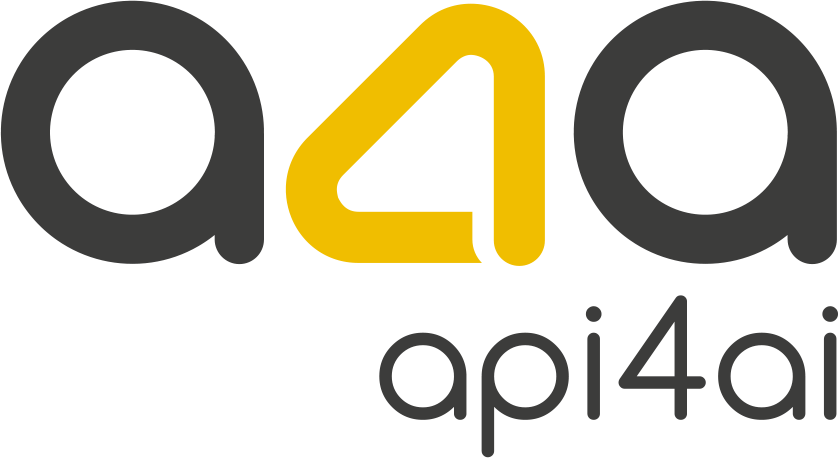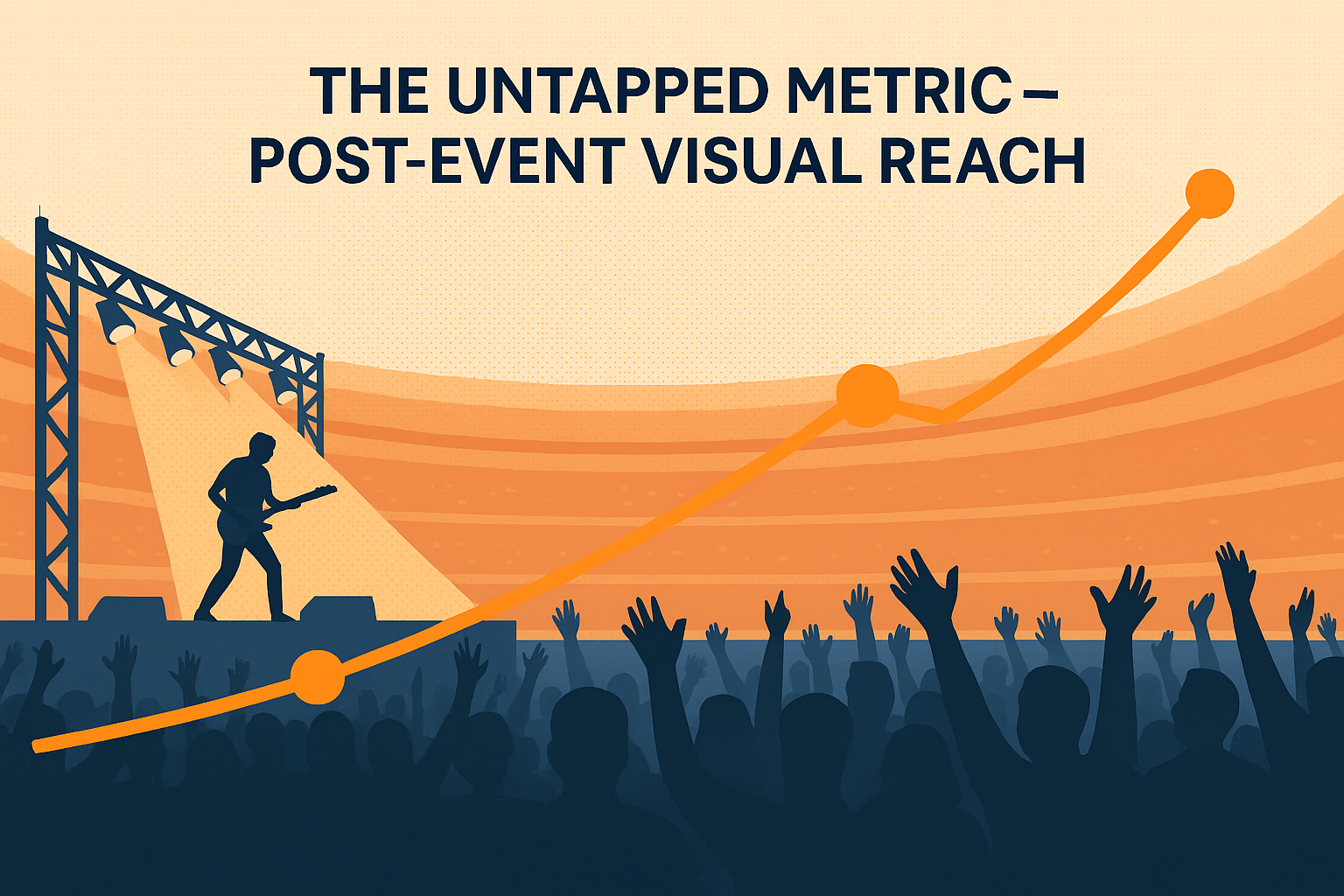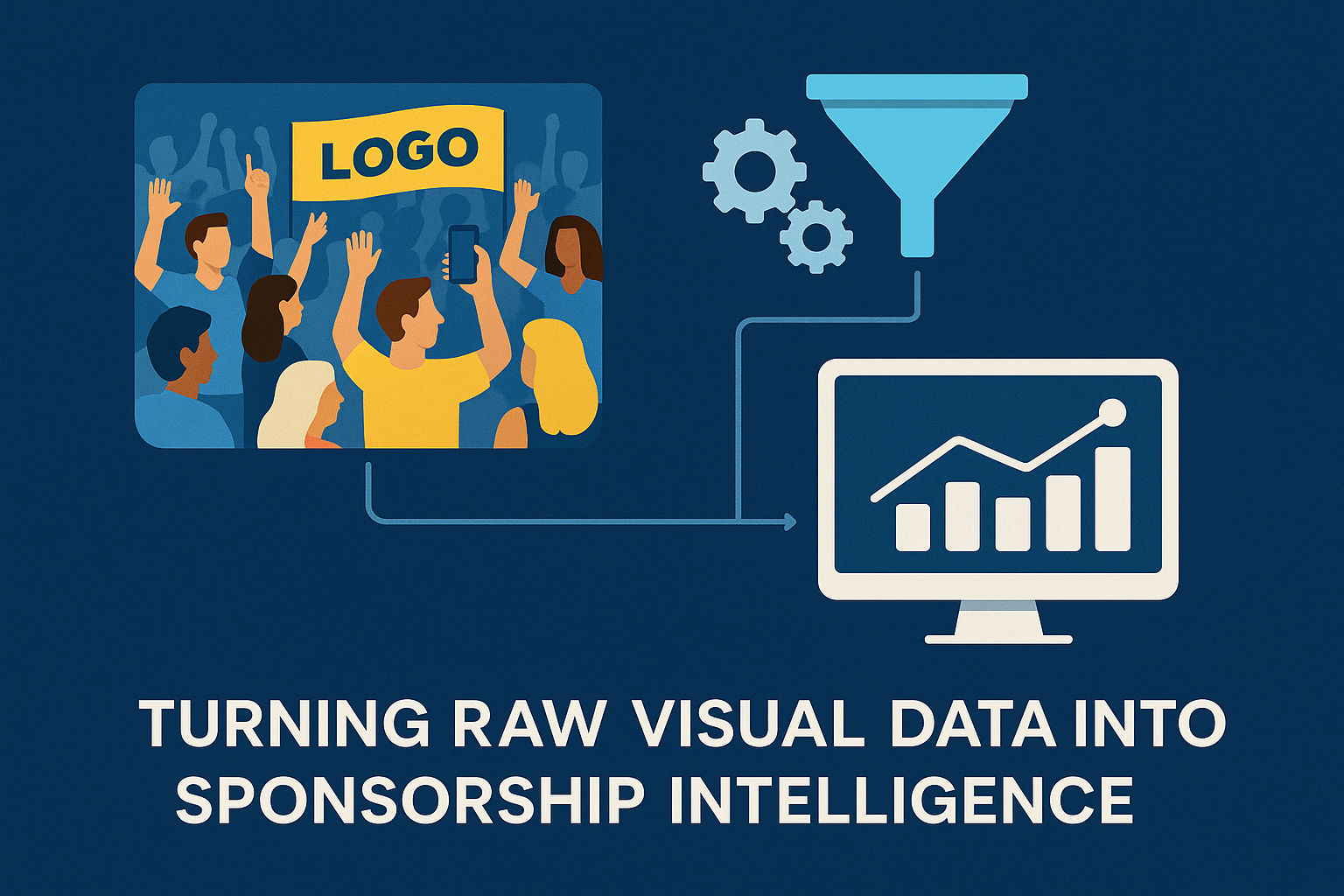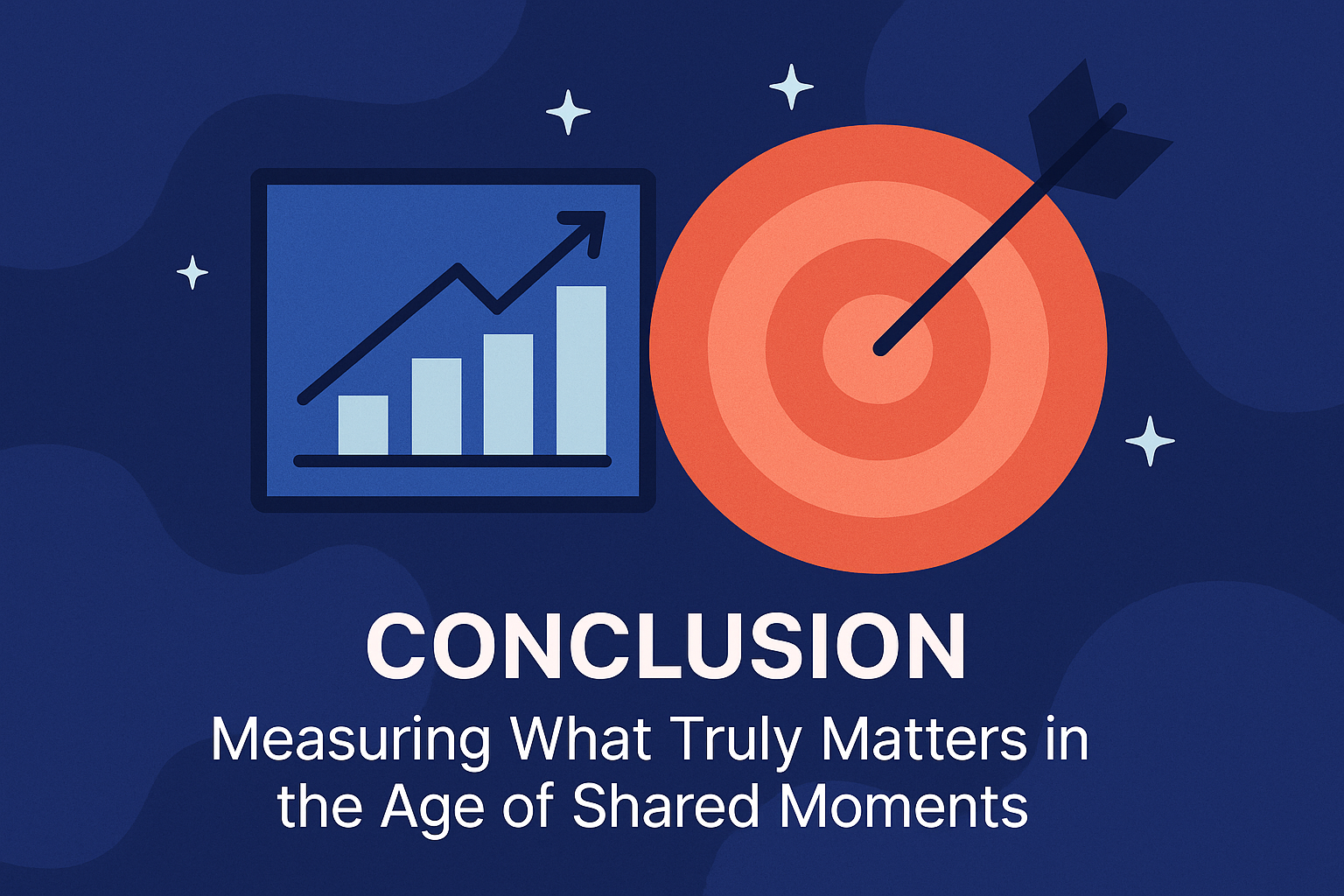Tracking Brand Mentions in Fan Photography
Introduction — The Missed Value in Fan-Captured Moments
In modern sports and live entertainment, the stands have become an extension of the stage. At any given moment during a football match, a tennis final, or a sold-out arena concert, thousands of spectators are not just watching — they’re capturing. Every smartphone raised is a potential broadcast tower, sending moments to friends, family, and the wider online world within seconds.
For sponsors, this represents a massive but often invisible form of exposure. Corporate logos on jerseys, stage banners, LED boards, and even branded merchandise are embedded in these fan-generated images. Yet, in most post-event reports, this exposure never appears. Traditional sponsorship valuation still relies heavily on broadcast reach, official media coverage, and sanctioned photography. That leaves a blind spot: the organic visual content created and shared by fans without any direct involvement from the event organizer or the brand itself.
This blind spot is not trivial. Fan photography is typically more trusted, more relatable, and more likely to drive authentic engagement than official advertising material. It circulates in private group chats, niche fan forums, and smaller social networks where brand monitoring tools rarely look. These are not mass-audience impressions, but they are deep, targeted, and emotionally charged — the kind of attention money can’t easily buy.
From a business standpoint, ignoring this content means undervaluing sponsorship deals, missing real reach in ROI calculations, and overlooking opportunities to engage with highly motivated audiences. It also means that competitor presence in these same visual spaces goes unmeasured, leaving decision-makers without a full competitive picture.
The solution lies in bringing visual analytics to this overlooked data stream. By systematically detecting and quantifying brand appearances in fan-shot photos, leaders can finally connect the dots between event presence and real-world digital visibility. This is not a “nice-to-have” metric; it’s an untapped source of market intelligence that can influence sponsorship negotiations, justify marketing spend, and refine placement strategies for future events.
The Untapped Metric — Post-Event Visual Reach
When sponsorship ROI is reported today, the numbers usually come from predictable sources: broadcast airtime, press photos, official highlight reels, and controlled social media posts. While these channels are important, they capture only the curated, corporate-approved side of brand visibility. The reality is that some of the most influential impressions happen well beyond these official boundaries.
Fan-generated photography — the candid snapshots, selfies, and behind-the-scenes moments shared online — represents a parallel universe of exposure. It’s organic, unpaid, and often far more authentic than the polished marketing feed. These images travel through personal networks, niche communities, and influencer micro-audiences that traditional monitoring systems fail to capture. In many cases, the cumulative reach of this grassroots content rivals, or even exceeds, official coverage.
This creates a significant measurement gap. A brand might feature prominently on stage backdrops or team jerseys and appear in thousands of crowd-shot images, yet none of these impressions enter the official sponsorship valuation. That omission not only underreports actual reach but can also weaken a brand’s negotiating position in renewal discussions. Without data, executives are left with a partial picture — and partial data leads to suboptimal decisions.
From an investment perspective, the cost-efficiency of this channel is unmatched. Every instance of a logo in a fan photo is a zero-cost impression — no extra media buy, no production spend. It is essentially free brand amplification, but it only becomes a strategic asset if it is tracked, quantified, and linked to meaningful business outcomes.
Forward-looking sponsorship and marketing leaders are beginning to treat post-event visual reach as a core KPI, not an afterthought. Measuring it means closing the gap between what actually happens in the crowd and what gets reported in the boardroom. In an environment where every dollar of marketing spend is scrutinized, having a full, data-backed view of audience exposure is not a competitive advantage — it’s becoming a baseline expectation.
The Data Source — Where Fan Photos Live and How to Find Them
To measure post-event visual reach effectively, brands must first understand where fan-generated images actually reside. This is not as simple as typing a hashtag into a search bar. The reality is that fan photography is fragmented across platforms, formats, and privacy settings, making discovery both an art and a science.
1. Public Social Media Platforms
Instagram, TikTok, X (formerly Twitter), and Facebook remain the most visible repositories of fan-shot content. Event-specific hashtags, geotags, and trending topics can surface thousands of relevant images within hours of an event. However, these platforms are increasingly limiting direct API access, which means brands need compliant data collection strategies or partnerships with social listening providers.
2. Niche Communities and Forums
Outside the mainstream, fan culture thrives in specialized spaces — from Reddit subcommunities to independent forums dedicated to a sport, a music genre, or even a specific artist or team. These smaller venues often host in-depth photo threads that never appear in public search results but are highly valuable for their engaged, targeted audiences.
3. Messaging Apps and Private Groups
Platforms like WhatsApp, Telegram, and Discord have become digital clubhouses for fans. Photos shared here can spread widely within closed networks, but they are only accessible through direct partnerships, influencer collaborations, or voluntary submission campaigns. For brands, tapping into these spaces requires trust and relationship-building, not just technology.
4. Event Organizers and Media Partners
Another overlooked avenue is collaboration with the event organizers themselves. Many collect large volumes of fan photos through official apps, contests, or post-event galleries. When integrated into a measurement framework, these assets can significantly enhance the accuracy and completeness of visual exposure reporting.
For executives, the key takeaway is that fan photography discovery is a strategic capability, not a one-off effort. It demands a mix of technical tools, rights-compliant sourcing methods, and relationship-driven access. The brands that invest in this infrastructure can create a near-complete view of their organic visual footprint — while competitors remain blind to a large portion of the audience conversation.
From Pixels to Insights — How Visual Brand Detection Works
Collecting fan photos is only the first step. The real value comes from transforming this unstructured visual content into measurable, board-ready insights. That requires a systematic process where artificial intelligence — specifically, logo and brand detection technology — plays the central role.
1. Ingesting and Preparing the Images
Once fan-shot photos are gathered from public sources, private collaborations, or event partnerships, they need to be processed in a standardized way. This involves cleaning up file formats, filtering out irrelevant images, and ensuring compliance with privacy and usage rights. At this stage, automation reduces time-to-analysis and eliminates human bottlenecks.
2. Detecting Brand Appearances at Scale
This is where AI-powered visual recognition comes into play. Cloud-based solutions, such as a Brand Mark and Logo Recognition API, can scan each image to identify brand logos, even in challenging real-world conditions: low lighting, partial occlusion, unusual camera angles, or when the logo appears on unconventional surfaces like merchandise or fan-made signs. This eliminates the guesswork and inconsistency of manual review, making the process scalable from hundreds to hundreds of thousands of images.
3. Contextual Tagging and Categorization
Detection alone is not enough — context matters. Advanced systems can classify where and how the logo appears:
On fixed signage (stadium boards, stage banners)
On apparel or merchandise
In proximity to products or activation spaces
This contextual data is critical for evaluating placement effectiveness and linking visibility to sponsorship strategies.
4. Aggregating into Business-Critical Metrics
The final step is converting detection results into KPIs executives can act on. This means quantifying:
Total organic exposures
Unique image sources and reach estimates
Engagement rates linked to brand appearances
Share of visual presence compared to competitors
These metrics are easily integrated into post-event reports, media valuation models, and sponsorship ROI dashboards.
Why This Matters at the Executive Level
Without automation, tracking brand presence across thousands of fan images is cost-prohibitive and prone to error. With AI-driven detection, the process becomes reliable, repeatable, and near real-time. This not only improves accuracy but also enables faster decision-making — whether renegotiating a sponsorship, planning next season’s branding placements, or responding quickly to an unexpected spike in organic visibility.
In short, visual brand detection turns the chaos of crowd-generated imagery into a strategic asset. It bridges the gap between marketing’s creative ambitions and finance’s demand for measurable ROI, ensuring that every brand appearance is counted and valued.
Turning Raw Visual Data into Sponsorship Intelligence
Detecting your brand in fan photography is only the beginning. For senior decision-makers, the true value emerges when those detections are transformed into insights that inform strategy, influence negotiations, and protect brand investments. The goal is not to generate another set of marketing vanity metrics — it’s to create sponsorship intelligence that drives measurable business outcomes.
1. Moving from Counts to Context
Raw numbers showing how many times a logo appears are helpful but incomplete. The competitive advantage comes from understanding the where, when, and how of each appearance. Was the logo visible in premium seating areas that signal exclusivity, or in high-energy crowd scenes that drive mass appeal? Did it appear in close-ups that dominated the image, or as background detail in a wider shot? This context helps quantify not just the quantity of impressions but their quality.
2. Linking Visibility to Engagement
Once visual exposures are identified, they can be cross-referenced with audience interaction metrics — likes, shares, comments, and reposts. This step reveals the emotional resonance and viral potential of the exposure. A single well-composed fan photo featuring your brand could generate more engagement than hundreds of official images, and this correlation can be used to guide creative placement for future events.
3. Benchmarking Against Competitors
Sponsorship decisions don’t happen in isolation. By applying the same detection methodology to fan photos containing rival brands, you can calculate share of visual presence within a given event. This enables data-driven positioning in negotiations — whether justifying a premium renewal rate or demonstrating the need for more prominent placements.
4. Feeding Strategic Decisions Across Departments
Marketing gains a clearer understanding of organic brand lift and how to amplify it in future campaigns.
Sponsorship teams get hard evidence to strengthen partnership negotiations and secure better terms.
Finance receives quantifiable ROI data that aligns marketing impact with budget efficiency.
Legal and compliance teams can identify unauthorized brand use or placements in high-risk contexts.
5. Turning Insights into Predictive Power
Over time, as data from multiple events is collected, patterns emerge: which placements perform best, which event types generate the highest organic visibility, and which audience segments are most likely to share branded images. This transforms sponsorship measurement from a reactive reporting exercise into a predictive planning tool — one that informs both investment and creative strategy.
For C-Level leaders, this is the bridge between marketing visibility and commercial leverage. It’s the shift from knowing that the logo was seen to knowing what that visibility means for the bottom line — and using that intelligence to make smarter, faster, and more profitable decisions.
Strategic Applications — Beyond the Event
While measuring brand visibility in fan photography is a powerful way to value sponsorship ROI, its potential extends far beyond post-event reporting. For executives, this capability opens a range of strategic opportunities that can influence competitive positioning, creative strategy, and brand governance across the entire marketing ecosystem.
1. Competitive Benchmarking at Scale
By applying the same visual tracking to rival brands, companies can build a precise view of their share of visual presencein any given event or category. This is particularly valuable when negotiating sponsorship packages or evaluating competitive threats. If a competitor’s logo appears more often in organic fan content despite having a smaller official presence, it signals a need to reassess placement strategies or negotiate more prominent visibility.
2. Creative Placement Optimization
Not all brand placements are equal. Tracking where fan photos capture your logo — whether on stage banners, jerseys, merchandise, or digital displays — reveals which placements attract the most organic attention. Over time, this intelligence can guide creative decisions: prioritizing high-yield positions, adjusting color contrast for visibility, or innovating placement formats that stand out in crowd-generated imagery.
3. Brand Safety and Context Monitoring
Fan photography is unfiltered by definition. While this authenticity drives engagement, it also carries risk if your brand appears alongside inappropriate, controversial, or off-brand content. Visual detection tools can flag these instances quickly, allowing communications teams to respond before reputational damage spreads. This proactive monitoring can be as critical to brand health as tracking positive exposure.
4. Market and Audience Insights
Geotag and timestamp data from fan photos can uncover where brand engagement is strongest geographically and demographically. This intelligence can inform regional marketing strategies, product launches, and event sponsorship priorities. It’s a way to turn unstructured crowd content into structured market insight.
5. Campaign Amplification Opportunities
Identifying high-quality, fan-generated content that prominently features your brand opens the door to collaboration. With proper permissions, these images can be integrated into official campaigns, adding authenticity and extending reach at minimal cost. This also fosters goodwill with fan communities, which can increase organic sharing over time.
Why This Matters for Leadership
For executives, these applications shift visual brand tracking from a tactical analytics exercise to a strategic asset. It becomes a decision-making tool that strengthens negotiations, sharpens creative execution, mitigates reputational risk, and deepens market intelligence. In an increasingly competitive sponsorship landscape, the organizations that treat this capability as a year-round discipline — rather than a one-off event measurement — will consistently extract more value from every partnership and placement.
Conclusion — Measuring What Truly Matters in the Age of Shared Moments
In the modern sponsorship and events ecosystem, visibility is no longer confined to the official camera lens. The most authentic, relatable, and far-reaching impressions often originate from the crowd itself — in photos taken spontaneously, shared instantly, and amplified organically through personal networks. These images form a parallel stream of brand exposure that is both vast in scale and rich in emotional resonance, yet too often goes unmeasured.
For C-Level leaders, the implications are clear. If a brand’s presence exists in the real world but is invisible in the data, it’s a missed opportunity — both for demonstrating value and for guiding strategy. Incomplete measurement means undervaluing sponsorship ROI, misjudging competitive position, and overlooking channels of influence that require no additional spend to activate.
The technology to close this gap already exists. AI-powered visual recognition, such as advanced Brand Mark and Logo Recognition solutions, makes it possible to detect, quantify, and contextualize brand appearances in thousands — even millions — of fan-shot images with precision and speed. When integrated into a disciplined analytics framework, this capability transforms raw pixels into business intelligence that can influence high-stakes decisions in sponsorship negotiations, media planning, and brand governance.
Looking ahead, the brands that treat fan-generated content not as a side note but as a core measurement pillar will lead the next wave of sponsorship strategy. They will negotiate from a position of evidence, place their assets where they perform best, and respond in real time to emerging opportunities and risks. In a marketplace where authenticity drives engagement and engagement drives value, measuring what truly matters is no longer optional — it is a competitive necessity.
The age of shared moments has rewritten the rules of visibility. Now it’s up to leadership to ensure the metrics evolve accordingly.






